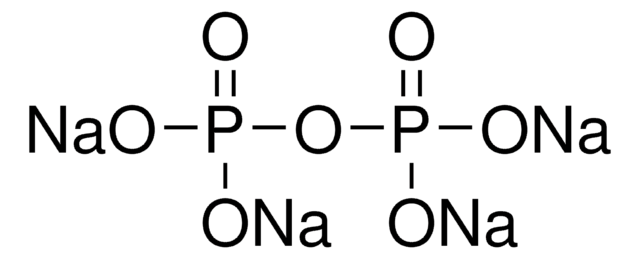S4379
Sodium phosphate glass
Type 45
Synonym(s):
sodium orthophosphate glass
Sign Into View Organizational & Contract Pricing
All Photos(1)
About This Item
Recommended Products
Looking for similar products? Visit Product Comparison Guide
General description
Sodium phosphate glass is composed of Na2O–P2O5. It is used as a sequestering agent in hard water treatment and also as a dispersant in clay processing and pigment production. In Na-ion batteries, sodium phosphate glass can be used as a solid electrolyte.
Application
Sodium phosphate glass type 45 (polyP45) can be used as a reference material in the extraction and quantification of inorganic polyphosphate residues found in microorganisms.
Biochem/physiol Actions
Reported to be of use in protein binding and sequestering and in studies on bone calcification.
Other Notes
Nan+2PnO3n+1; n = the average number of phosphorus (P) atoms in the chain.
Storage Class Code
13 - Non Combustible Solids
WGK
WGK 1
Flash Point(F)
Not applicable
Flash Point(C)
Not applicable
Choose from one of the most recent versions:
Already Own This Product?
Find documentation for the products that you have recently purchased in the Document Library.
An improved method for extraction and quantification of polyphosphate granules from microbial cells
Mukherjee C and Ray K
Protocol Exchange, 10 (2015)
Fan Zhang et al.
Proceedings of the National Academy of Sciences of the United States of America, 112(14), 4381-4386 (2015-02-26)
Marine sponges are major habitat-forming organisms in coastal benthic communities and have an ancient origin in evolution history. Here, we report significant accumulation of polyphosphate (polyP) granules in three common sponge species of the Caribbean coral reef. The identity of
Harikiran Nistala et al.
Human molecular genetics, 29(21), 3516-3531 (2020-10-27)
Neurodevelopmental disorder with microcephaly, hypotonia and variable brain anomalies (NMIHBA) is an autosomal recessive neurodevelopmental and neurodegenerative disorder characterized by global developmental delay and severe intellectual disability. Microcephaly, progressive cortical atrophy, cerebellar hypoplasia and delayed myelination are neurological hallmarks in
Our team of scientists has experience in all areas of research including Life Science, Material Science, Chemical Synthesis, Chromatography, Analytical and many others.
Contact Technical Service






